Planting raspberries in spring - tips for beginners
Although there is a lot of controversy among gardeners regarding the timing of planting, practice shows that the survival rate is higher when planting raspberries in the spring. During the summer period, the seedlings are well strengthened, fully rooted and are able to withstand cold winter frosts without shelter.
Content
Planting methods
The planting time of raspberries - in spring, autumn or summer, does not matter so much. However, it is important to plant the seedling correctly, prune it and provide it with proper care. This is the main condition for good survival rate and quick harvest. The most common two methods of planting raspberries - bush or in a hole and trench.
Bush
Planting raspberries in holes does not require preliminary soil preparation, digging and fertilization. Pits are made 50-55 cm deep and 45-60 cm wide and prepared 1.5-2 weeks before planting. Immediately before planting, 3.5-4.5 kg of compost or humus are applied. You can also apply only mineral fertilizers: superphosphates 25-35 g, ammonium nitrate 12-20 g, potassium salts 5-12 g per hole. The best option would be the simultaneous application of mineral and organic fertilizers, in this case, their dose is halved. Top dressing is mixed with fertile soil and poured into the bottom of the pit. To create the most favorable conditions for the development of the root system, when planting, the plant should also be covered with earth from the upper layer. It is important to provide proper care for the raspberries.
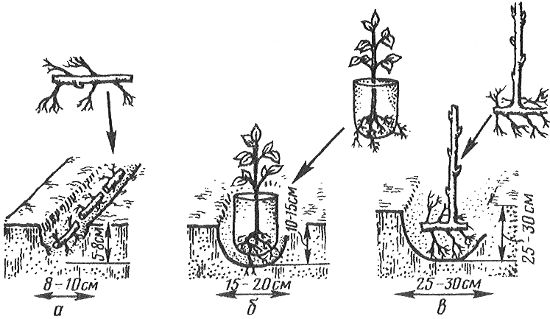
Raspberry planting scheme in spring
When the bush is lowered to the bottom of the planting pit and added in droplets, it is necessary to shake it easily so that the entire space between the roots is well filled with soil. It is not recommended to excessively deepen the bush, this greatly inhibits its development and growth, at the same time, a shallow planting can lead to drying out of the basal buds. It is desirable that after watering and soil shrinkage, the root collar is located at the same level with the ground. After planting, the bushes are watered, slightly compacted with their feet and mulched with sawdust, peat or straw.
Into the trench
Compared to the previous method, planting raspberries in a trench in the spring is more laborious and time-consuming. However, in this case, the entire area of the future raspberry grove is provided initially with the same amount of nutrients, which has a beneficial effect on yield in the future.
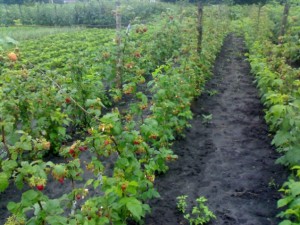
It is necessary to prepare the trenches in advance, at least 22-26 days before planting young raspberries. Such preparation greatly facilitates subsequent care and promotes the early rooting of seedlings. In the spring, when warm, dry weather sets in, before planting raspberries, the soil is cleared of weeds, roots and other debris in the selected area. To reduce the formation of weeds in the aisles, you can cover them with black film, old linoleum or roofing felt. The cleared area is marked with pegs. After that, planting trenches with a depth of 42-52 cm and a width of 45-55 cm are dug along a stretched cord. The length of the trench corresponds to the length of the future raspberry tree, and their number corresponds to the planned rows of raspberries.
A mixture of black fertile soil, vermicompost, rotted manure or compost is laid at the bottom of the trench with a layer of 10-15 cm. On top, double superphosphate 120-180 g is evenly scattered. Nitrogen fertilizers are not applied during planting, this slows down the process of adaptation and rooting, weakens the plant before wintering. Also add 1.5-2.5 scoops of ash, depending on the length of the trench.This supplement should be handled with caution.
Although it improves the taste of berries, an excess of ash alkalizes the soil, as a result of which a young bush may lack magnesium and iron, and the risk of root system disease increases.
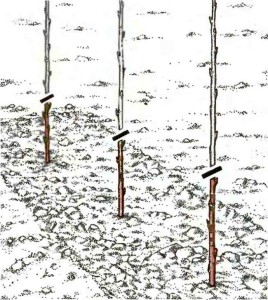
Selection of seedlings
For successful planting, seedlings are chosen with 2-4 shoots of an average thickness of 5-8 mm, a well-developed root system with a length of at least 13-16 cm and a thick lobe. If the seedlings were purchased away from the site and cannot be planted immediately, they should be covered with a dense wet cloth or dug in temporarily to avoid drying out the roots. You cannot keep the roots wet for a long time in a plastic bag, as they begin to rot and turn brown from moisture. You should also give preference to plants with bright green leaves, not damaged or yellowed and twisted.
Immediately after planting, it is necessary to cut the seedlings to 25-40 cm, from the soil level, leaving only the buds, which have not yet grown, so that the plant does not waste nutrients on the shoots, but takes root well.

The choice of soil and place for the raspberry tree
A well-lit area protected from cold winds should be allocated under the raspberry tree. Rows of raspberries are best located northeast to southwest. In partial shade, raspberries can grow, but fruiting will be low. Remontant varieties, such as Hercules, are especially sensitive to the lack of light. In this case, fully formed buds of the Hercules variety are placed mainly on unripe shoots, which will be strongly stretched. Such buds will certainly die during winter frosts or during frosts in the spring. Taking proper care of your bushes is very important.
Raspberries love neutral and slightly acidic, well-drained and at the same time retaining moisture, fertile, light loamy soils. Raspberry can be diluted on sandy and sandy soil, but in this case, it is necessary to apply a large amount of organic fertilizers annually in spring and regular watering.
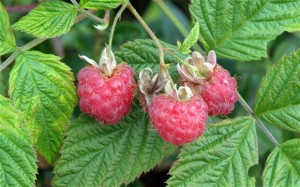
On medium loamy soil in a cold, rainy, little sunny summer, even with proper care, the shoots may still not ripen. Due to excessive moisture in the soil, the growth of the shoots will be continuous and intense. As a result, without timely pinching, they are able to stretch up to 2.5-3.5 m by the end of August without signs of ripening.
Tips for beginners
The video at the end of the recording tells how to choose the right raspberry seedlings. The video also shows how she needs to be cared for. In the first year after the establishment of the plantation, you may find in the spring that some of the seedlings have not taken root. It is undesirable to leave the raspberry in a sparse state, even if the losses are insignificant. A revision of the young plantation should be carried out at the end of the first year in the summer, removing sluggish, dried, not engrafted plants, and replacing them with new ones in the fall, according to the variety. If the plantation is small and the attack was insignificant, it is possible to plant green scions of raspberries in the summer, while maintaining moderate soil moisture, without swamping and without bringing it to dryness.
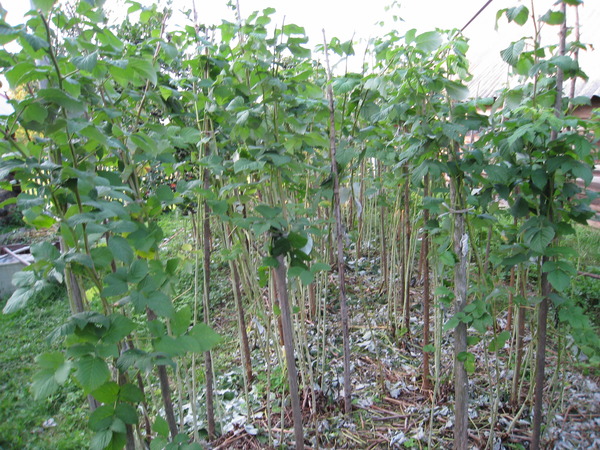
When the seedling has fresh, strong shoots, you should cut off the old stump at soil level, preventing it from fruiting. Failure to harvest in the first year ensures the speedy rooting of the bush and the development of strong shoots in subsequent years.
If raspberries were planted in fertile soil, and a sufficient amount of fertilizer was applied during planting, then in the first year the seedlings are not fed.
Raspberry bushes require careful maintenance in the first year. Watering raspberries with plenty of water can increase the yield and size of the berries. It is carried out before flowering, when the first ovaries of berries appear and during their ripening. At the same time, 2.5-3.5 buckets of water are given per 1 sq. M. Watering is carried out, as a rule, by sprinkling or in shallow furrows so as not to damage the root system of plants.
Video "Planting raspberries - which way is better"
How to choose planting material, what to pay attention to, how to plant raspberries correctly, other nuances of its agricultural technology and care are shown in this video.
